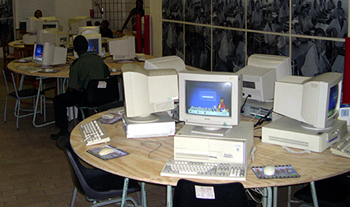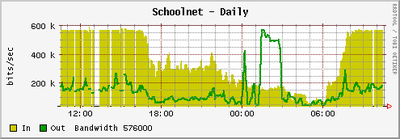Overview
This is the story of an NGO continually challenged to find innovative ways of meeting its objectives – an on-going process requiring versatility, flexibility, resourcefulness, improvisation and a certain level of opportunism. Multiple sub-projects and initiatives ensued each with their own objectives feeding directly or indirectly into the broader objectives of SchoolNet Namibia. The following list of selected milestones[1] for the first three years illustrates the diversity of activities, projects and partnerships.
Contents
Time line
| 2000 | |
| February | First General Meeting of SchoolNet Namibia . |
| March | Launch of "Kids on the Block" volunteer programme . |
| April | Alpha version of Open Source Server solution for school local area network released. |
| September | Insect@thon 2000 roadshows - 5 regional events, one national event. |
| October | Geckos' Stone Award for publicity campaign "Youth empowerment through Internet" . |
| 2001 | |
| February | AED/LearnLink Project technologies rolled out to 4 Teacher Resource Centre s. |
| May | Three-year financing agreement signed with Swedish International Development Agency (Sida)[2]. |
| July | Establishment of SchoolNet (Educational) Trust.
WorldTeach Volunteers deployed as ICT trainers to schools . |
| August | Domestic Violence Advocacy Website competition . |
| September | Establishment of stable Open Source Linux Terminal Server LAN solution, using diskless "thin" clients .
Demonstration of solar powered wireless internet solution for remote schools - Spring Energy Fair . |
| November | SchoolNet Internet Service Data Centre established at Polytechnic of Namibia . |
| 2002 | |
| February | Establishment of SchoolNet Internet Service Provider (ISP) – Virtual Private Network, Virtual Private Dial-up Network, with “E-rate” 0700 national number for dial-up clients; 0800 toll-free number for help-desk and technical support services . |
| March | Beta-version low-cost local area computer networks - (LTSP) Open Source + Open Office applications + refurbished diskless workstations deployed to new schools, as well as upgrades of earlier versions at existing school clients, especially single-dial clients. |
| June | SchoolNet Namibia established as Thinkquest Africa country coordinator . |
| September | NIED and SchoolNet co-host HIV/AIDS website competition for schools
Independent human resources investigation and SchoolNet policy document completed. SchoolNet "HIV/AIDS in Katutura " website launched . |
| October | Launch of SchoolNet Volunteer (=troubleshooter), informal trainer programme at schools - 18 trainers qualify for deployment for 3 - 8 weeks+ . |
| November | First 10 schools provided with solar powered electricity in northern Namibia, first two wireless schools in northern Namibia . |
| December | African Connection, SchoolNet Africa, SchoolNet Namibia, World Links for
Development conference in Windhoek on “Satellite and Wireless Connectivity for Rural Schools and Development”. First top-level meeting between SchoolNet and Telecom Namibia toward the establishment of a Development Alliance. |
| 2003 | |
| February | Completion of pilot solar school installations in northern Namibia . |
| April | Telecom Namibia MD and senior officials of the Ministry of Basic Education, Sport and Culture visit off-grid solar-powered wireless schools in northern Namibia . |
| September | SchoolNet transition to DireqLearn OpenLab solution for school computers, introducing Learnthings and the DireqLearn Educational Portal . |
| December | SchoolNet showcased for the Global E-Schools Initiative at the ICT4D platform, WSIS, Geneva .
|
Although the time line is incomplete, the table does tell a story of continuous growth and learning towards a goal of ICT-enabling schools in Namibia and the vision of “Youth empowerment through Internet”.
Community orientation
The launch of “Kids on the Block” (March, 2000) indicates an early awareness of the importance of community involvement. The kids on the block were generally unemployed youths who had left school either ineligible for or unable to attend tertiary or further education. SchoolNet Namibia believed in their inherent capabilities, and provided opportunities for learning skills in servicing computer hardware and various types of ICT support. It did not take long for participants to gain confidence in their own abilities and become productive contributors to the initiative – a stepping stone towards formal employment typically in the ICT/education sector in Namibia.
Relationships with community and other organisations were formed and maintained. For example, the insect@thon events continued for a while in collaboration with the National Museum, the ISP was set up at the Polytechnic of Namibia with ISP administration models provided by AfricaOnline and UUNet, and other projects with various NGOs came up from time to time typically related to health and education.
Affordable
SchoolNet supplied schools with an affordable solution for PC labs and internet connectivity. By sourcing used computers and refurbishing them as thin clients and installing free/libre software on servers, SchoolNet was able to reduce costs and at the same time provide a comprehensive solution with benefits and opportunities that would be precluded by proprietary solutions.
Software
The software included tools for managing thin clients and educational software for teachers running computer laboratories. SchoolNet added open educational resources and optional educational content bundles[3] (more details below). Synergies with SchoolNet Namibia (and SchoolNet Africa, etc.) piloting the distribution enabled on-going refinement of the software and the establishment of a wide user base across Africa.
Innovation
SchoolNet Namibia pioneered technologies and approaches that solved problems associated with African conditions coming up with innovations where they were most needed. Sometimes, when faced with challenges (e.g. restrictive and monopolistic communications legislation), and not locked into a particular way of doing things, there was a need to and freedom to innovate. Examples include:
- Transparently pioneering the then “illegal” use of ISM band 2.4gHz WIFI in distributing internet access to disadvantaged schools in urban and rural settings.
- The unavailability of technical support meant SchoolNet had to build the capacity locally. This was beneficial for the individuals being trained, in terms of local community capacity building, cost effectiveness (particularly with respect to transport on account of the distances involved, and the rates charged by city service providers), and sustainability.
| Rose Tables Using locally purchased shutter-board cut to size and shape by a local contractor, these circular table-tops were shipped to schools where they were mounted on the school's reject (broken) classroom desks - five old desks per table-top. Each circular table-top can comfortably hold 5 PCs/monitors, with ample room on either side of the keyboard for papers and text books. |
The design of the computer laboratories. In the early days, learners were repeatedly tripping over cables as they moved around the lab., and were unable to face their teachers and/or peers to interact effectively in class. A more dynamic learning environment was created by designing labs with circular (locally made) “rose tables” with room for five workstations.
In terms of connectivity, challenges included the lack of phone lines and other existing infrastructures to enable local networking or internet access. Where bandwidth was available it was typically insufficient for access by learners and too expensive. SchoolNet Namibia was willing to improvise and found multiple solutions for the thin client laboratories and for accessing the internet culminating in solar powered wireless schools in northern Namibia.
The key was not to restrict themselves to any one technology but to make the best of what was available to enable access for the particular school under consideration. Innovation and improvisation.
Bandwidth
Internet bandwidth was a persistent problem (to the very end and beyond). The figure below shows the pattern, an encouraging high usage rate with incoming capacity typically completely full during the day with relatively low usage at night.In practice, learners and teachers would access locally hosted resources during the day, and operations requiring high bandwidth such as software updates, sharing results and distributing new learning resources to the servers at the schools were performed at night.
Learning resources
Including a great collection learning resources (see Educational Resources under Activities for details) on each server proved invaluable as service levels for internet access fell short of expectations. A dispute with Telecom ensued concerning poor or non-existent upstream service issues and the sequestration of SchoolNet WIFI equipment purchased with Sida funds (provided to SchoolNet)[4]. These two issues, as well as Telecom's commercial use of two 51 meter stayed masts belonging to SchoolNet over several years without discussion, consent or fair trade, remains at the core of this unresolved dispute and had a direct bearing on any resolution of XNet and Telecom claims against SchoolNet.
- ↑ After Ballantyne, P. 2003. Evaluation of Swedish Support to SchoolNet Namibia. Report to Sida.
- ↑ Now called the Swedish International Development Cooperation Agency: http://www.sida.se.
- ↑ For example, learning resources in the LearnThings collection. See http://www.direqlearn.org/ for current status and updates in respect of DireqOpenLab. These were not necessarily free of restrictions.
- ↑ An outline of the dispute is provided in Appendix 3: The Ongoing XNet and Telecom saga .

